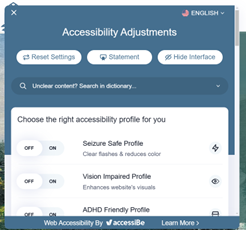How to elevate your church website to welcome people with disability
Church websites are a very helpful tool to share with your local community about your ministries and gatherings. They help people find out what time church starts, what ministries and groups exist for various ages and demographics, and what the current sermon series is.
For a visitor who has disability or is neurodivergent, up-to-date information about accessibility, what happens during a service, and what to expect is essential. Visitors can include individuals looking for a church to attend, as well as families who have a child with disability or is neurodivergent.
Many people rely on researching a venue before attending. This could be for a few reasons, including:
- seeing if the physical access suits mobility or safety needs e.g. ramps, fencing, toilets, and seating arrangements.
- understanding the structure of a church service so as to reduce anxiety of the unknown, e.g. being aware if there are unspoken cues to sit and stand, where to sit, what to wear, or the duration of the program.
- being confident that they will be able to participate, e.g. knowing there is a hearing loop or subtitles on the screen, space to move, or being included in activities.
Here are three tips for enhancing your church website to help all people find out more about your church, so they feel included and welcome.
1. Include an ‘Accessibility’ tab as a separate page for easy-to-find information.
This helps to make it clear and easy for people to find specific information, rather than having to search through various tabs and pages to find what they’re looking for. It serves as an “everything you need to know” in the one spot.
On this page you can include information about access points, toilets, a social story about what to expect during the service or program, site maps, and what their options are if they have support needs.
Use lots of photos. Photos help to visualise and see what you are describing, as well as being able to ascertain whether their accessibility needs can be met. For example, not all ramps and bathrooms meet legal building codes and requirements.
The picture on the left shows the homepage of the website of Living Hope Anglican
It’s also helpful to include a message inviting people to request accessibility needs, which could also initiate a helpful pastoral conversation.
2. Accessibility widget for your website
There are web providers who can enable an accessibility widget on the page. This enables the browser to select the best option for easy readability of the information on your site. A widget like this would come with features such as changing the font size, changing the colour palette, and having a read aloud option.
Above are examples from the website of Christ Church Lavender Bay
A good widget will often come with a cost that would need to be considered in your budget but is well worth investigating.
3. A welcome video
A video that has a welcome message and shows people around the site will enable visitors to get a feel for the place before they can commit to coming along to a service or program. This goes beyond an online service, where you’re likely to only be seeing what’s happening in the front area of the church building. A welcome video gives a tour of the space and an insight for what gatherings might be like for them to participate in.
Here’s a great example of a welcome video from Lower Mountains Anglican Church
Be sure to include captions in all videos, not only for those with hearing loss, but for people who may benefit from being able to read and hear at the same time.
People with disability or who are neurodivergent need to know that your church is a place that they can come to. They won’t turn up and hope for the best without the information they need. Our church websites, and other online platforms for that matter, need to communicate to the wider community that it is possible to attend and that everyone is welcome.
For further information on accessible church websites, go to page 101 in the Everyone Welcome Handbook produced by the Sydney Anglican Diocese.
For further reading, check out these two articles:
https://sydneyanglicans.net/news/what-people-with-disabilities-want-to-know-about-your-church/54050
https://reachaustralia.com.au/8-ways-to-fix-a-bad-church-website/
Here you’ll find information about helpful fonts and colours, particularly for people with dyslexia.




